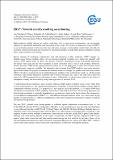Por favor, use este identificador para citar o enlazar a este item:
http://hdl.handle.net/10261/207061COMPARTIR / EXPORTAR:
 SHARE
BASE SHARE
BASE
|
|
| Visualizar otros formatos: MARC | Dublin Core | RDF | ORE | MODS | METS | DIDL | DATACITE | |

| Título: | ERA*: Towards an eddy resolving ocean forcing |
Autor: | Trindade, Ana CSIC ORCID; Portabella, Marcos CSIC ORCID ; Stoffelen, Ad; Verhoef, Anton; Vall-llossera, Mercè | Fecha de publicación: | abr-2019 | Editor: | European Geosciences Union | Citación: | Geophysical Research Abstracts 21: EGU2019-1601-1 (2019) | Resumen: | High-resolution satellite derived sea surface wind data, such as those from scatterometers, are increasing lyrequired for operational monitoring and forecasting of the ocean. We present an improved version of ERA*, an ocean forcing product which keeps the time and space coverage of atmospheric model fields, but adds the accurately observed local mean and variability of wind scatterometers, to make these datasets suitable for, among others, high-resolution ocean forcing. Recent attempts of combining scatterometer data and numerical weather prediction (NWP) outputs, i.e. blended ocean forcing products, allows for an increased temporal resolution (e.g., daily) but generally only resolves NWP spatial scales of about 100-150 km. Therefore, information on the wind-current interaction, the diurnal wind cycle and the wind variability in moist convection areas is lost in such products. Moreover, known systematic NWP model (parameterization) errors are in fact propagated at times and locations where no scatterometer winds are available. The alternative, direct forcing from NWP results in even more extensive physical drawbacks. We propose to maintain the increased temporal coverage in a gridded wind and stress product (ERA*), but also to maintain the most beneficial physical qualities of the scatterometer winds, i.e. 25-km spatial resolution, wind-current interaction, variability due to moist convection, etc., and, at the same time correct the large-scale NWP parameterization and dynamical errors. Additionally, we correct these winds for the effects of atmospheric stability and mass density, using stress equivalent 10 m winds, U10S. A scatterometer-based correction, using accurate, unbiased, high spatial resolution ocean vector winds from several scatterometers, i.e. the Advanced Scatterometers (ASCATs) on board Metop satellites and the OSCAT scatterometer onboard Oceansat-2, is proposed as a new angle to tackle this problem, i.e. to reduce NWP local wind biases accounting for satellite sampling characteristics. Since ERA local biases are relatively persistent over time but such persistence is regionally dependent (e.g., persistency is longer in the tropics than in the extratropics), we test different configurations of ERA*, i.e. with different temporal windows (from 1 to 5 days) and varying number of scatterometers (i.e. different combinations of the above mentioned scatterometer systems) to find the best quality forcing product. The new ERA* gridded ocean forcing product is validated against independent scatterometer data, i.e. the 25-km HSCAT (onboard HY-2A) wind product. HSCAT is a good wind reference since the orbit pass (6am/6pm) is very different from that of ASCAT-A/B (9:30am/9:30pm) and OSCAT (12:00am/12:00pm). Globally, there is a reduction of the vector root-mean-square error in ERA* w.r.t. ERA interim of more than 10%. Overall, the 1-day temporal window and the multiple scatterometer correction lead to the best quality ERA* global wind product, although such wind quality depends on the region. In particular, this ERA* product outperforms ERA in the tropics, where moist convection and wind-current interaction are not well resolved by the latter. Scores of the bias and standard deviation error support the above statements. Moreover, in contrast with ERA, ERA* is able to resolve eddy scales similar to those resolved by scatterometers, as shown by wind spectral analysis | Descripción: | European Geosciences Union (EGU) General Assembly, 7-12 April 2019, Vienna, Austria.-- 1 page | Versión del editor: | https://meetingorganizer.copernicus.org/EGU2019/EGU2019-1601-1.pdf | URI: | http://hdl.handle.net/10261/207061 | Identificadores: | issn: 1607-7962 |
| Aparece en las colecciones: | (ICM) Comunicaciones congresos |
Ficheros en este ítem:
| Fichero | Descripción | Tamaño | Formato | |
|---|---|---|---|---|
| Trindade_et_al_2019.pdf | 35,01 kB | Adobe PDF |  Visualizar/Abrir |
CORE Recommender
Page view(s)
119
checked on 18-abr-2024
Download(s)
52
checked on 18-abr-2024
Google ScholarTM
Check
Este item está licenciado bajo una Licencia Creative Commons

